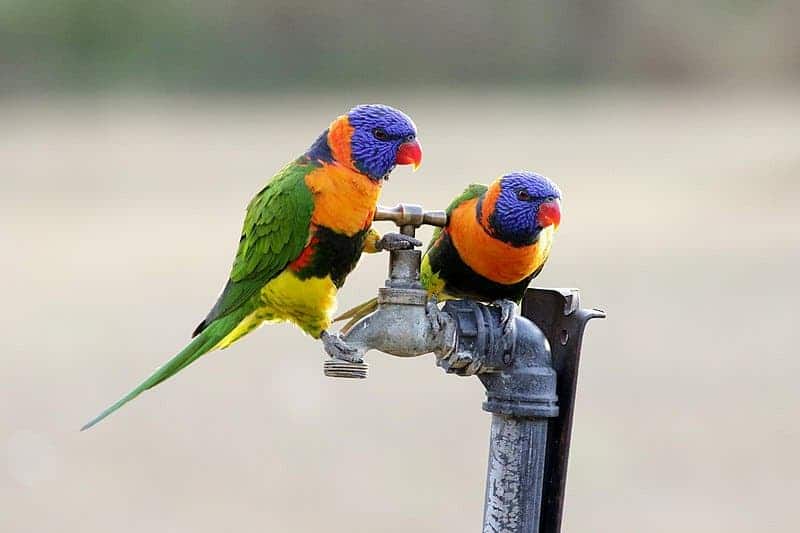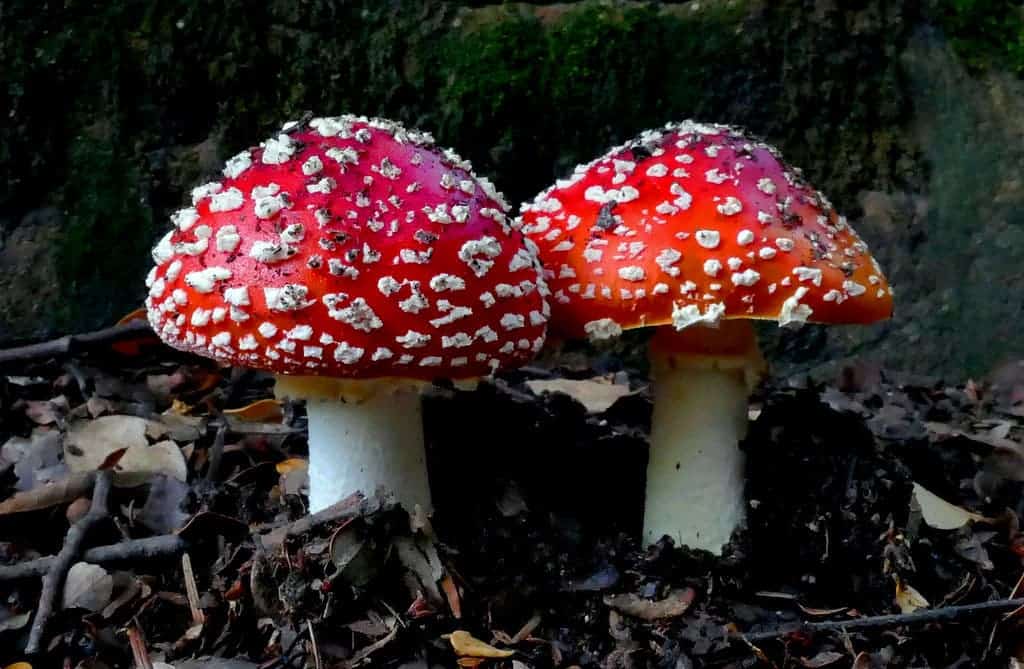Drinking isn’t good for you, but watching parrots get drunk is both healthy and entertaining. Not for the parrots, though.
There’s no day like a weekend day — cause that’s when we get to party. But humans aren’t the only animals that like to abuse their systems with various chemicals. In fact, a lot of animals do it; and get into trouble afterward. We’ve seen the shenanigans that animals go through in love (and lust), some of which are amusingly similar to those we humans cause or experience. So let’s see whether our furry and feathered friends also mirror us in the bad choices we make on a night out on the town (spoiler: they do).
The Darwin Drinking Awards
Northern Australia is the only place on Earth that I know of which has three seasons: a wet season, a dry season, and a drunken parrot season.

Image via Wikimedia.
Just before the wet season, roughly in mid-to-late December, the local Weeping Boer-bean trees (Schotia brachypetala) are flowering. This brings swarms of red-collared lorikeets to the area to feed on the nectar of the trees’ flowers. However, after a while, some of the birds start to sway a little bit — and then fall out of trees. Darwin locals report that the birds lack coordination and that they seemingly lose their ability to fly and sometimes even to walk. Vets say the birds act similar to drunken people. They also seem to experience disorientation, energy loss, and perhaps headaches, all very familiar hangover symptoms.
While the possibility of a virus affecting these birds hasn’t yet been ruled out, the event may have more to do with the trees — which are also known as the Drunken Parrot Tree, I’ll let you judge for yourself. So far, local animal caretakers and vets provide safe, quiet places for the parrots to recover — which can take months in some rare cases according to National Geographic — while providing sweetened porridge and fresh fruit. The prevailing theory is that the parrots get drunk off their tails on nectar and fruit fermented in the baking Australian heat.
Tripping Reindeers
Reindeer live in Siberia (in North America too, but they’re called caribou there). The hallucinogenic mushroom Amanita muscaria also lives in Siberia, among other places. And the reindeer like to get really, really high on the ‘shrooms during those long and dreary winter months.

Reindeer that partake of the mushrooms have been documented to act almost as if drunk, running around aimlessly, making strange noises, and twitching their heads.
“They have a desire to experience altered states of consciousness,” Huffington Post cites researcher Andrew Haynes, who studied the behavior in the wild. “For humans a common side-effect of mushrooms is the feeling of flying, so it’s interesting the legend about Santa’s reindeer is they can fly.”
He also adds that herdsmen drink the reindeer’s urine to get high themselves.
“Fly agaric is found across the northern hemisphere and has long been used by mankind for its psychotropic properties, but its use can be dangerous because it also contains toxic substances,” he explains for the Pharmaceutical Journal.
“Reindeer seem to metabolise these toxic elements without harm, while the main psychoactive constituents remain unmetabolised and are excreted in the urine. Reindeer herders in Europe and Asia long ago learnt to collect the reindeer urine for use as a comparatively safe source of the hallucinogen.”
Sharing, it seems, really is caring.
Popped-up Wallabies
Wallabies are adorable, diminutive kangaroos native to Australia and New Guinea.

Image via Pxfuel.
Opium poppy farmers on Tasmania (an island off the south Australian coast) have reported that wallabies will sometimes break into their fields to dine on the flowers, which are the raw material for prescription painkillers.
Although exactly which species of wallabies are responsible is still unknown, the animals have been seen eating poppies before running around in circles and eventually passing out, according to a BBC report. Lara Giddings, the attorney general for the island state of Tasmania even described the animals as being “high as a kite” and creating crop circles.
“The one interesting bit that I found recently in one of my briefs on the poppy industry was that we have a problem with wallabies entering poppy fields, getting as high as a kite and going around in circles,” Lara Giddings told a parliamentary hearing on security for poppy crops. “Then they crash.”
“We see crop circles in the poppy industry from wallabies that are high.”
Rick Rockliff, a spokesman for poppy producer Tasmanian Alkaloids, told the BBC that these wallaby incursions aren’t very common, although other animals have been spotted “acting unusually” in the poppies.
Australia is a major producer of raw materials for the painkiller industry, supplying around half of the world’s (legally-grown) opium. And, it seems, the main supplier for wallabies as well.
Bees on a binge
Bees keep the world turning, but that doesn’t seem to stop them from functional alcoholism.
The bee nervous system is similar enough to that of humans for alcohol to have similar effects on them. In fact, researchers sometimes use bee colonies as models to test out the effects of alcohol intoxication in humans and other vertebrates. For example, a team of researchers at Ohio State University routinely gives bees ethanol — drinking alcohol — to see how it affects them. Unsurprisingly, they found that it affected their flying, walking, and grooming.
“Alcohol affects bees and humans in similar ways — it impairs motor functioning along with learning and memory processing,” Dr Julie Mustard, an entomology researcher at the university, explained to the BBC.
But bees seem in no way content to limit their day-drinking to the lab. Just last year, Australian Parliament’s head beekeeper Cormac Farrell explained that the bees, which could be seen sometimes dropping on the ground around the Australian House of Parliament in Canberra, are just really blitzed. Sadly for the bees, they can sometimes drink themselves to death, and the queens aren’t very understanding of them — they will post guards at the entrance of their hives to keep any ‘merry’ bees from getting in.
“As the weather heats up, the nectar in some Australian flowers will ferment, making the foragers drunk,” Farrell told The Canberra Times last year. “Usually this makes them a bit wobbly, and if they come back to the beehive drunk the guards will turn them away until they sober up.”
“The drunk bees are kept out of the hive to stop the honey from fermenting inside, which could hurt the whole colony,” he added.
Only introduced and exotic honeybees seem affected, with Farrell noting that he had not seen any drunk native bees, of which Australia can boast 2000 species.
So, are bees just the victims of excellent work ethic and fermenting sugar? It doesn’t appear that way — bees just seem to enjoy getting smashed hard. Charles Abramson of Ohio State University told Newscientist that while most animals need to be coaxed into drinking alcohol, “we can get [bees] to drink pure ethanol, and I know of no organism that drinks pure ethanol – not even a college student.”
A bee, he adds, will drink the equivalent of a human downing 10 liters of wine in a single sitting. Flawless work ethic indeed!
Puff puff porpoise
Dolphins… like to pass toxic pufferfish around to get high.
The behavior was first reported on by marine biologist Lisa Steiner in 1995. She was studying a group of rough-toothed dolphins roughly in the region of the Azores when she noticed that some of them were pushing an inflated pufferfish around and rubbing their faces against it. Which was an odd sight, as that pufferfish uses one of the most lethal substances on Earth, tetrodotoxin, to protect itself from, among others, dolphins. Later on, Steiner would hypothesize that the dolphins were only exposed to tiny amounts of tetrodotoxin, and this resulted in a high, not death. Which is an ideal outcome in my book.
It’s still unclear whether the dolphins are actually getting a chemical kick out of the pufferfish or if they’re just harassing the poor animal for sport. The main points of contention are that tetrodotoxin isn’t known to cross the brain-blood barrier, and that it’s extremely deadly — one pufferfish contains enough to kill 30 full-grown people. However, in episode two of the BBC One documentary film, “Dolphins: Spy in the Pod,” a group of dolphins was filmed hunting pufferfish and biting into it but not eating it, then sharing the fish with their mates.
So this one is still a bit up in the air. But no matter whether the fish is used as a drug or a simple toy, given how toxic it is, it’s definitely dangerous.
These are a few of the more unusual stories of animals binging, but they’re certainly not the only ones. Jaguars like to chew on the roots of yagé vines — a main component of the hallucinogenic brew ayahuasca — and their diminutive cousins love catnip. And, well, humans are animals too. While it’s definitely a lot of fun reading about their shenanigans, hangovers aren’t, so enjoy your own real-life shenanigans in moderation.


